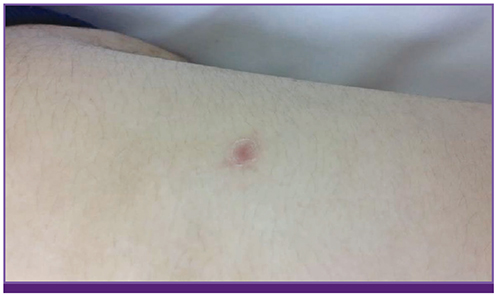Infect Chemother.
2015 Jun;47(2):133-136. 10.3947/ic.2015.47.2.133.
Sacral Herpes Zoster Associated with Voiding Dysfunction in a Young Patient with Scrub Typhus
- Affiliations
-
- 1Department of Internal Medicine, Yeungnam University Medical Center, Daegu, Korea. sarang7529@hanmail.net
- KMID: 2069001
- DOI: http://doi.org/10.3947/ic.2015.47.2.133
Abstract
- When a patient presents with acute voiding dysfunction without a typical skin rash, it may be difficult to make a diagnosis of herpes zoster. Here, we present a case of scrub typhus in a 25-year-old man with the complication of urinary dysfunction. The patient complained of loss of urinary voiding sensation and constipation. After eight days, he had typical herpes zoster eruptions on the sacral dermatomes and hypalgesia of the S1-S5 dermatomes. No cases of dual infection with varicella zoster virus and Orientia tsutsugamushi were found in the literature. In the described case, scrub typhus probably induced sufficient stress to reactivate the varicella zoster virus. Early recognition of this problem is imperative for prompt and appropriate management, as misdiagnosis can lead to long-term urinary dysfunction. It is important that a diagnosis of herpes zoster be considered, especially in patients with sudden onset urinary retention.
Keyword
MeSH Terms
Figure
Reference
-
1. Whitley RJ. Varicella-zoster virus. In : Mandell GL, Bennett GE, Dolin R, editors. Mandell, Douglas, and Bennett's principles and practice of infectious diseases. 7th ed. Philadelphia: Churchill Livingstone, Elsevier;2010. p. 1963–1969.2. Whitley RJ. Varicella-Zoster virus infection. In : Longo DL, Fauci AS, Kasper DL, editors. Harrison's principles of internal medicine. 18th ed. New York: McGraw-Hill;2012. p. 1462–1466.3. Ragozzino MW, Melton LJ 3rd, Kurland LT, Chu CP, Perry HO. Population-based study of herpes zoster and its sequelae. Medicine (Baltimore). 1982; 61:310–316.
Article4. Chen PH, Hsueh HF, Hong CZ. Herpes zoster-associated voiding dysfunction: a retrospective study and literature review. Arch Phys Med Rehabil. 2002; 83:1624–1628.
Article5. Lee DH, Kim HW, Suh HJ, Cho DH. Volding dysfuction associated with Herpes Zoster. Korean J Urol. 1999; 40:226–228.6. Park BS, Kim JI, Lee SJ. Comparison of recovery periods according to treatment modalities in Zoster-associated voiding dysfunction. J Korean Continence Soc. 2007; 11:36–40.
Article7. Broseta E, Osca JM, Morera J, Martinez-Agullo E, Jimenez-Cruz JF. Urological manifestations of herpes zoster. Eur Urol. 1993; 24:244–247.
Article8. Richmond W. The genito-urinary manifestations of herpes zoster. Three case reports and a review of the literature. Br J Urol. 1974; 46:193–200.9. Imafuku S, Takahara M, Uenotsuchi T, Iwato K, Furue M. Herpes zoster-associated voiding dysfunction in hematopoietic malignancy patients. Int J Dermatol. 2008; 47:36–39.
Article10. Yamanishi T, Yasuda K, Sakakibara R, Hattori T, Uchiyama T, Minamide M, Ito H. Urinary retention due to herpes virus infections. Neurourol Urodyn. 1998; 17:613–619.
Article11. Park KS, Yoon TR, Kim SK, Park HW, Song EK. Acute postoperative herpes zoster with a sciatic nerve distribution after total joint arthroplasty of the ipsilateral hip and contralateral knee. J Arthroplasty. 2010; 25:497.e11–497.e15.
Article12. Mahajan SK, Kaushik M, Raina R, Thakur P. Scrub typhus and malaria co-infection causing severe sepsis. Trop Doct. 2014; 44:43–45.
Article13. Phommasone K, Paris DH, Anantatat T, Castonguay-Vanier J, Keomany S, Souvannasing P, Blacksell SD, Mayxay M, Newton PN. Concurrent Infection with murine typhus and scrub typhus in southern Laos-the mixed and the unmixed. PLoS Negl Trop Dis. 2013; 7:e2163.
Article14. Chu H, Park SM, Cheon IS, Park MY, Shim BS, Gil BC, Jeung WH, Hwang KJ, Song KD, Hong KJ, Song M, Jeong HJ, Han SH, Yun CH. Orientia tsutsugamushi infection induces CD4+ T cell activation via human dendritic cell activity. J Microbiol Biotechnol. 2013; 23:1159–1166.
Article
- Full Text Links
- Actions
-
Cited
- CITED
-
- Close
- Share
- Similar articles
-
- Sacral Herpes Zoster Associated with Voiding Dysfunction
- The Treatment Experience Used Famciclovir in Herpes Zoster with Voiding Dysfunction in Female Patients
- Voiding Dysfunction associated with Herpes Zoster
- A Descriptive Review of Herpes Zoster-Associated Voiding Dysfunction
- Pulmonary Artery Thrombosis Associated with Scrub Typhus



